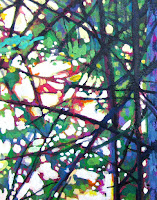Hello Everyone,
I promised my dad that I would send him a color lesson. I thought maybe others would benefit from my little diatribe.
The most important color concept is how to mix them. Sounds simple, right?
On the left, for example are a couple of primaries mixed together to produce some pretty boring secondaries. These dull mixtures can be improved upon by knowing which combinations will create the more luminous outcome.The second color wheel demonstrates alternative choices resulting in more saturated colors.
If you "map" out generally where your pigments are on the color wheel your choices will be improved.
Always ask yourself "Does this color lean towards a cool or a warm color?"
For instance, let's take Lemon Yellow and we would like to make a green. Is this yellow "cool" or more towards the orange(warm) range? For green we want two "cool" colors. Now, we need to pick a blue. Is it towards red like an Ultramarine or towards a green like Manganese Blue? On the right you can see a nice green over the duller original choice. This is Lemon Yellow and Manganese Blue. Try other pairs keeping in mind that the colors will be more resonnating in the mixture if they lean towards each other. But they don't have to, you are experimenting so you can utilize both( dull and bright) to your best advantage.
If I had choosen the Ultramarine Blue, which tends towards purple, this reddish blue mixed with a greenish yellow would have acted as if it were mixed with its complimentary color( the color that lies directly across on the color wheel). This is a classic way of quieting a color by adding it's opposite. Color will gray up as it recedes in space so the dulling of color is as useful as the brightening. Think of your picture as a symphony and you are the conducter. Pull up the brass section! And shoosh the violins.
So below is a map of some of my acrylic colors. Try making your own. Squinking helps to see the overtones in the pigment. Is it warm or cool?

Next, is the relative "weight" of color. When you compare colors they are highly affected by the surrounding tones. You can make a gray dot in the middle of a purple field look yellow. And, the reverse is also true. This whole business is so subjective. Here's a little trick from art school. Look at your painting in a mirror. It will double the veiwing distance so you can see what is standing out the most in a painting. Is it unbalanced? That's your call. It might be part of an effect.
Lastly, my crudely painted leaf is one example of how to use
color for spacial effects. In the background, the blue is brought closer to the green range blending with the back of the leaf which is painted a bluish green. The two hues almost overlap each other creating an atmospheric feeling. Viridian green for the back of the leaf and Cyan Blue behind it.
The front, I added the Hansa Yellow to the Viridian. The smallest amount of any color can overpower alot of yellow, so go cautiously. At the front of the leaf, I put the complimentary color under the yellow green.This drives this edge forward and sharpens the difference between them. My blacks are never a straight black . I always add a dark rich compliment to exploit the tension between the hues. One of the laws in landscape painting is "The Law of Contrasts". The closer an object is to the veiwer the more definite edges it has, shown either with color and/or hightlights and shadows. The further back in space the less definition there is.
I used an Ultramarine Blue with a smidgen of Alizarin Crimson for the violet. Then I blended the two blues with a Thalo Blue to smooth out the background.

Any combination of red and blue paint will work. Your choice is a preference, not a rule book of right or wrong. This leaf could have been painted hundreds of ways.Over time some combinations become very pleasing. This is the beginnings of STYLE, in particular YOUR STYLE. And when you discover that, you have gone from walking to flying.
Happy Take Off !
I hope this was useful.
SKF







 In this painting, "Two Women Beside a Linen Chest with a Child" by Pieter de Hooch, the interior is neatly organized into sensible grids that relate in layers as you move through the space towards the back room. Notice the small patch of blue sky in the middle of the painting. I am reminded of virtual landscapes of the online games which seem to employ similar compositions.
In this painting, "Two Women Beside a Linen Chest with a Child" by Pieter de Hooch, the interior is neatly organized into sensible grids that relate in layers as you move through the space towards the back room. Notice the small patch of blue sky in the middle of the painting. I am reminded of virtual landscapes of the online games which seem to employ similar compositions.







 So the nature of how you divide up the whole becomes an understanding of inherent structures. These constructs exist at many layers with the human mind jumbling the pieces and reassembling them over and over in new ways.
So the nature of how you divide up the whole becomes an understanding of inherent structures. These constructs exist at many layers with the human mind jumbling the pieces and reassembling them over and over in new ways.































